This post may contain affiliate links. If you use these links to buy something we may earn a commission. Thanks.
Mushrooms are cultivated on a wide variety of mediums, one of which is logs, hardwood logs to be exact! Hardwood logs are used to grow mushrooms outdoors, and for some species, this is the best and only way they should be grown outside.
Anyone with access to fresh healthy hardwood needs to know what mushrooms to grow on logs. Most log-loving mushrooms are not only tasty but medicinal and even profitable.
Shiitake, oyster, turkey tail, chestnut, lion’s mane, nameko, reishi, maitake, and chicken of the woods mushrooms grow best on hardwood logs. Each type of mushroom prefers specific wood types over others, for example, maitake mushrooms produce best on oak wood.
Organizations, like North Spore, have seen which combinations yield the most by testing various hardwood species with all kinds of mushroom strains.
Having grown various mushroom strains ourselves, we’ve also seen the difference that log selection can make!
Related: Grow a Mushroom Garden at Home in 4 Steps
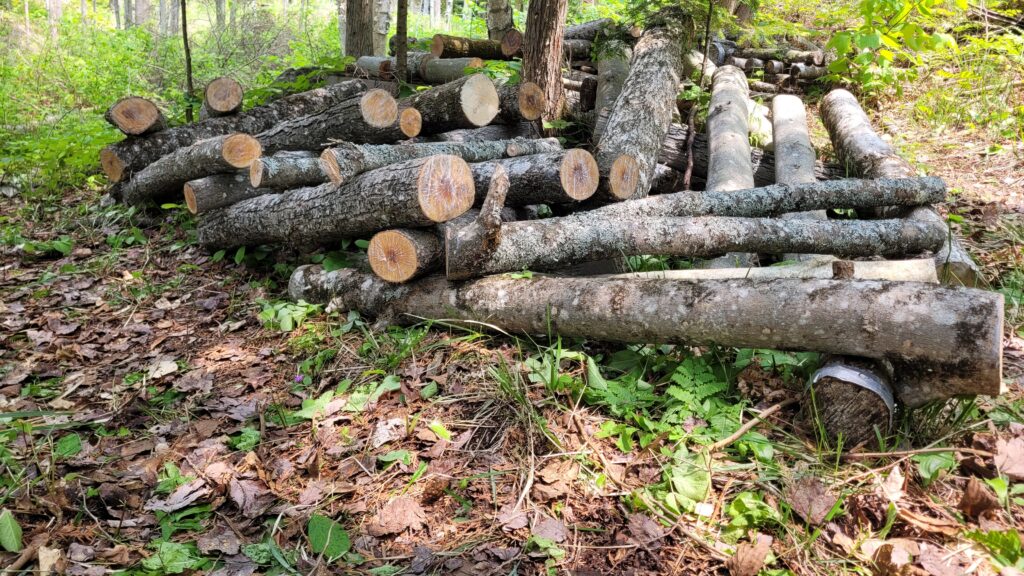
As we dive into the best mushrooms to grow on hardwood logs, we’ll cover more specifications such as their favorite log species, general information, and growth difficulty.
The type of wood species impacts the success differently for each mushroom strain. So when discovering which mushrooms grow on logs, you’ll also find out which logs each mushroom prefers!
Looking for quality (plug or sawdust) spawn for making mushroom logs? North Spore discounts orders using code: QUALITYSPAWN at checkout. Mushroom logs need to be inoculated with either sawdust spawn or plug spawn.
You certainly aren’t limited to growing oysters and shiitakes when it comes to logs. They both, however, are the easiest and most desirable to cultivate out of the rest. On the other hand, lion’s mane and chestnuts are rated as the most tasty among growers but are of intermediate level to cultivate on logs.
See: 9 Best-Tasting Mushrooms to Grow & What They’re Like
Shiitake

Shiitake mushrooms are one of the most well-known beginner-friendly mushrooms to grow. When growing them outside, they must be on logs (rather than beds).
Asian cuisine and cultures use them for their delicious umami flavors and medicinal compounds. Personally, we love their meaty and chewy texture.
Shiitake mushrooms grow best on alder, beech, hard maple, hophornbeam, hornbeam, oak, and sweetgum wood. Other species they grow on include basswood, birch, chestnut, eucalyptus, hickory, soft maple, pecan, sassafrass, sycamore, tuliptree, and willow (source).
We’ve successfully grown shiitake mushrooms on ironwood, beech, maple, and oak. We don’t, however, recommend ironwood for the sake of saving your drill bits!
Related: Essential Tools to Make Mushroom Logs (Complete List)
Shiitakes have an aggressive nature—making them one of the easiest to grow. Aggressive mushrooms outcompete other strains that compete for the same fresh food (your healthy logs).
Oyster
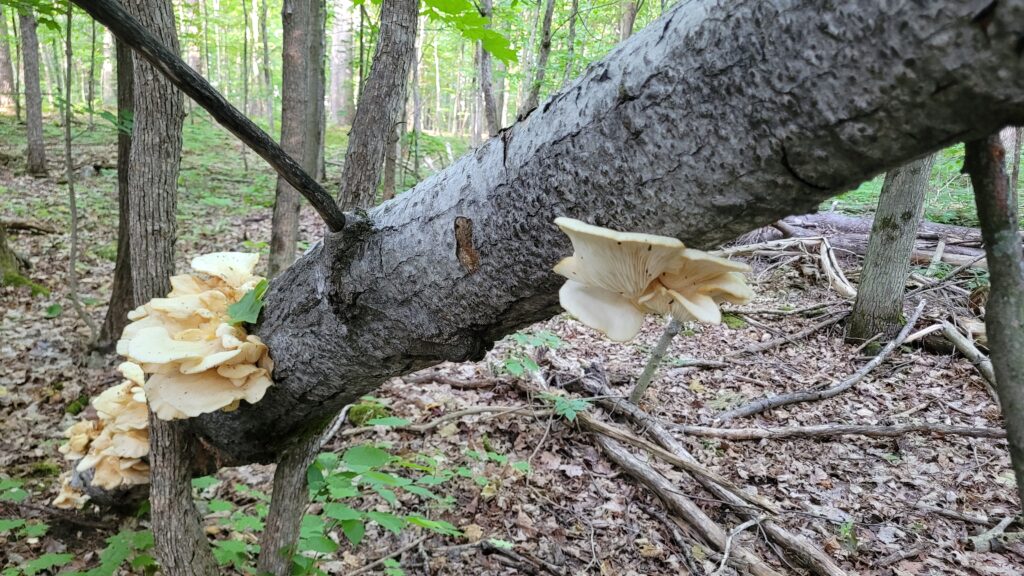
Oyster mushrooms are another popular and beginner-friendly choice. They grow aggressively on both logs and in beds of various substrates (logs, wood chips, straw, etc).
Aspens, cottonwood, tuliptree, and willow (poplars) are the best types of logs to grow various cold- and warm-climate oysters, and Italian oyster mushrooms. The second-best wood types include alder, bass, beech, birch, box elder, elm, hackberry, hemlock, maple, mulberry, palm, pear, and sycamore.
We have foraged and cultivated oysters on many wood types and find that they easily produce and spread—so long as you have hardwood.
In our experience, they are likely to outcompete and perform well on any hardwood log. It’s made sense for us to use what’s abundant. We mainly have oysters on maples, beeches, and poplars (poplars are in the willow family).
Oyster mushrooms of any kind are one of our favorites to cook with as they are sweet-scented and mild-tasting. Most other growers refer to them as an easy-to-grow and versatile-to-use favorite.
Yellow oysters have the strongest umami flavor, fried pink oysters tend to resemble ham, snow oysters are ‘seafoodie’ in texture while sweet in taste, and blue oysters we’ve yet to learn about. Italian oysters are the bulkiest and meatiest of them all.
Turkey tail
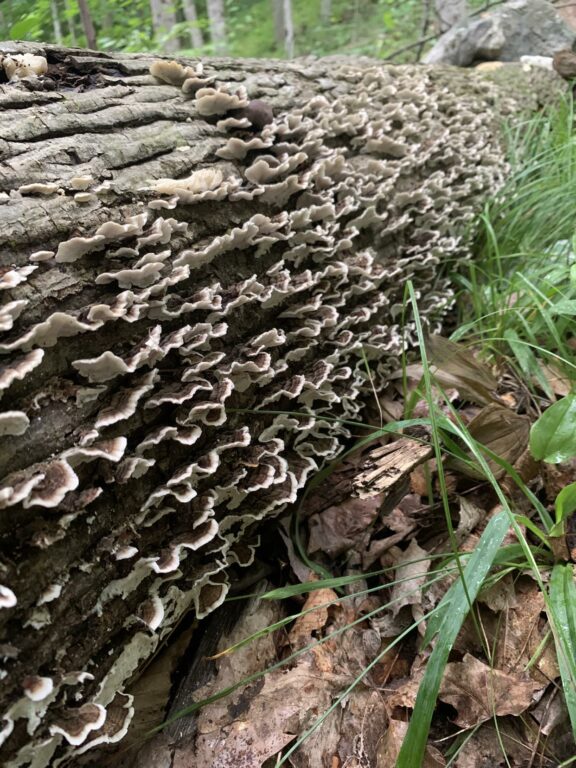
This is the species I recommend you grow when you don’t have access to healthy fresh hardwood, and you’re looking for the benefits of beta-glucans from mushrooms!
Turkey tail grows worldwide and in all kinds of woods. I’m positive some wood types are better than others, but to be honest, this aggressive species over-takes anything. Even old logs that have been infiltrated by something else. We’ve done it and seen it.
See: 3 Best Ways to Grow Turkey Tail (In + Outdoors)
Our very first round of logs was not, at all, ideal. They were old and infected by wild species. But we used them for shiitake, turkey tail, chicken of the woods, and lions mane—not knowing enough about log selection at the time. Shiitake produced a bit, but turkey tail thrived! The others didn’t do anything.
It goes to show just how easy turkey tail is. While easy, it isn’t typically considered a gourmet mushroom. Since you wouldn’t be planning to cook them up for eating. These mushrooms are like thin cardboard that doesn’t rip easily. But when brewed as tea they taste mild with a full-body feel and provide excellent health benefits.
Chestnut

Chestnuts are a popular all-time favorite among a few mushroom-grower communities. The taste, texture, and fairy-tale appearance are loved by most.
For efficiency and waste prevention, it’s best to grow these after successfully cultivating one of the species above. If you don’t get the log selection quite right the first time, you’re more likely to receive something from the easier mushrooms rather than nothing.
Once you’re good at choosing healthy and appropriate trees, you’re ready to try cultivating chestnuts. To do so, you’ll need to know the best wood type for chestnut mushrooms.
Aspens, beech, birch, cottonwood, hard maple, oak, and sweetgum are the best wood types to grow chestnut mushrooms. Without these, the next best options include alder, ash, basswood, cherry, elm, hackberry, mulberry, and willow (poplars, too).
We chose beech and maple wood for our chestnut mushrooms as we had good-sized trees to cut down of these types.
Lion’s mane
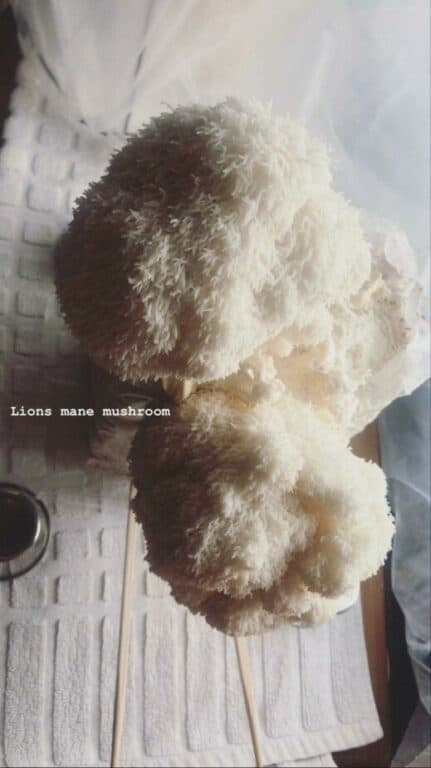
Lion’s mane mushrooms are known and loved for their versatility in the kitchen. A mild flavor, meaty texture, and spherical shape can turn into more than we’ve thought!
Traditional Chinese medicine has a long history of using lion’s mane for its bioactive components and anti-inflammatory effects. Specifically, Asian cultures have used it to “fortify the spleen, nourish the gut, and as an anticancer drug” (source).
So not only is lion’s mane delicious it’s healthy!
Most growers who have succeeded with beginner-friendly mushrooms opt for trying lion’s mane eventually. They require an intermediate cultivation skill level when grown outdoors on logs.
If you plan to grow lion’s mane outdoors, a few species of trees give the best results.
The best logs for lion’s mane include beech, hornbeam, or hard maple. If those aren’t options for you, alder, aspen, birch, black walnut, cherry, chestnut, cottonwood, elm, hackberry, soft maple, mulberry, oak, or sweetgum are the second best choices.
Recently, we inoculated maple, beech, and oak with lion’s mane mushroom. They have yet to colonize and present their first fruit but are looking good so far.
Lion’s mane mushroom is quite easy to grow indoors. Indoors, it’s considered a beginner mushroom.
If you’re unsure about committing to lion’s mane and would rather taste it first, we got ourselves a spray and grow kit first. Simply order it, open it, spray as needed, and you’ll get fruit relatively quickly. After tasting, you’ll know if cultivating logs is worth your time.
Do this with any mushroom offered—The QUALITYSPAWN discount code applies to spray and grow kits this month.
Nameko

Nameko mushrooms are on the other side of the ‘challenge’ bridge. This is where difficulty with cultivation begins and where it’s crucial to choose the most appropriate log species.
The easy thing about nameko mushrooms compared to the rest of this list, however, is they grow excellent on a wide variety of tree types!
Basswood, beech, buckeye, cherry, chestnut, cottonwood, hornbeam, maple, oak, and sweetgum are best for nameko mushroom yields. Alder, ash, basswood, birch, elm, hackberry, mulberry, pine, and willow family will work well as mushroom logs too.
If you have the right wood and previous mushroom log success, you’ll need a cooler and humid climate. According to North Spore experience, nameko mushrooms won’t grow well where it’s hot and dry.
When I surveyed my fellow mushroom growers on what their favorite mushrooms are, no one mentioned a peep about namekos. That doesn’t mean they aren’t delicious, or a favorite, but could mean that not many people grow them. We haven’t! Yet… Our climate would be great for them.
North Spore describes nameko mushrooms as “earthy… with subtle fruit-like hints, and an aroma reminiscent of cashews and butterscotch.”
Reishi
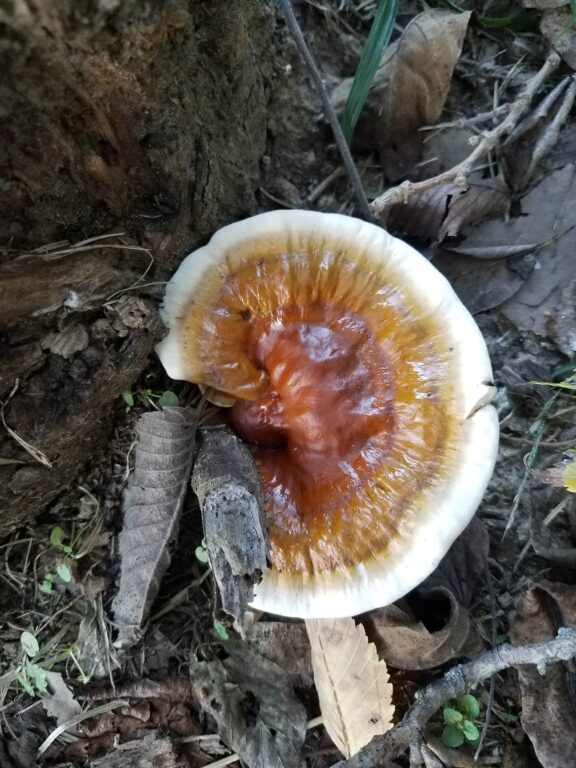
Two types of reishi mushrooms are often cultivated on logs outdoors. One type is very selective about wood choice, and the other can grow on multiple types of wood.
Red reishi grows best on hard maples or sweetgum wood. Secondary options include alder, birch, elm, mimosa, mulberry, oak, peach, sycamore, and the willow family, which includes poplars. Hemlock reishi only grows on hemlock wood—It won’t grow on any other.
Reishi is often consumed for its medicinal value (example) in the form of teas, tinctures, and powders.
Maitake
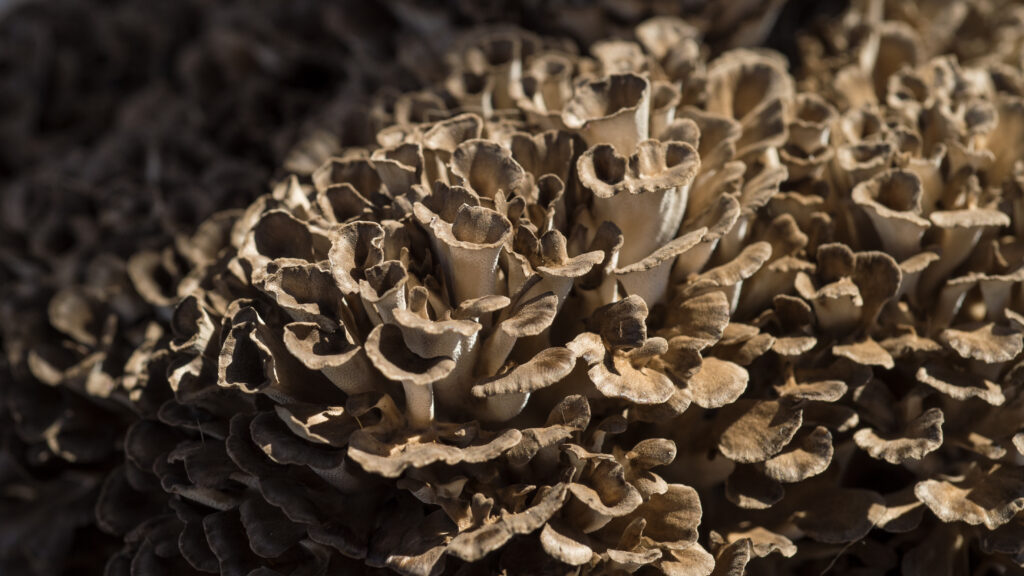
Maitake is a popular favorite since it has a chewy yet soft texture, adaptable flavor, and a meaty ‘pull.’
The bad news is this is not an aggressive mushroom species. So it’s an advanced species to grow outdoors but is easier in controlled conditions. Outside, however, isn’t controlled. So this is an advanced species to cultivate on logs.
But with the right logs, it isn’t impossible!
Oak logs are the only suitable wood type to grow Maitake (hen of the woods). This species can also grow on maple and elm wood, however, oak is the only recommended species when growing them outside.
The trouble with maitake is in the colonizing period. Healthy clean would hasn’t been overtaken by fungus yet, but as soon as it is available, something will begin to grow and colonize the ‘free’ space.
Maitake is easily left in the dust when aggressive competitors are around—and they are around. So as North Spore recommends “Inoculation works best when logs are steam sterilized, incubated and colonized in filter patch bags, then removed from bags and partially buried in a shaded spot.”
A few extra steps are necessary for success, you can’t just plug, wax, and set aside like the others above.
Chicken of the Woods
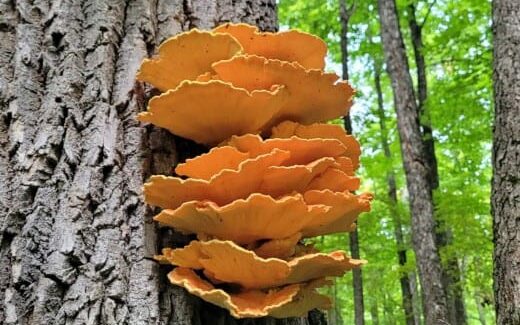
Chicken of the woods is one of our favorites, we’ve found them wild and haven’t attempted cultivation.
We pan fry them and toss them in hot sauce to eat like “wings”—without the bones. They are like juicy yet dry chicken at the same time.
Cultivating chicken of the woods on logs outside is similar to maitake. The extra step of bagging the log for the colonization period. It’s almost questionably worth the effort if you’re able to forage them.
If you can’t forage them, however, and you’ve got extra money to spend, time to experiment, and wish to taste these bad boys, I think you should go for it!
Be extremely selective with your tree type.
Picking the right log is as critical as bagging it for colonizing. The right log is a healthy oak.
Healthy oak trees make the best logs for cultivating chicken of the woods outdoors. If grown on the wrong species such as conifers and eucalyptus, this mushroom is toxic to consume. Maple wood is also acceptable but best to use oak for cultivating.
Up Next: Where to Find Fresh Wood for Mushroom Logs (9 Places)
Recent Posts
There’s no shortage of full-sun ground covers for zone 4 climates! Each plant in this list can withstand the frigid temperatures and also enjoy the hot sun in summer. Full sun means that a plant...
There's no shortage of full sun ground covers, not even in zone 3! Zone 3 climates offer hot but short-lived summers and very cold winters. So each plant in this list can withstand the frigid...
